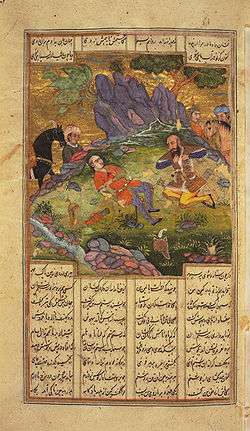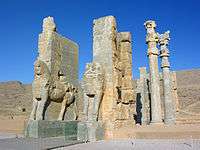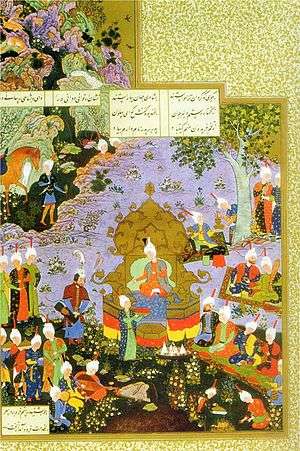Rostam
- For the historical general who fought at the Battle of al-Qādisiyyah for the Sasanian Empire, also mentioned in the Shahnameh, see Rostam Farrokhzād.

Rostam or Rustam (Persian: رُستَم, pronounced [ɾos'tæm, ɾʊs'tæm]) is the most celebrated legendary hero in Shahnameh and Iranian mythology. In Shahnameh, Rostam and his predecessors are Marzbans of Sistan (present-day Iran and Afghanistan). Rostam is best known for his tragic fight with Esfandiar, the other legendary Iranian hero, for his expedition to Mazandaran (not to be confused with today Mazandaran province), and for his mournful fight with his son, Sohrab, who was killed in the battle. Rostam was eventually killed by Shaghad, his half-brother. He was son of Zal and Rudaba.
Rostam was always represented as the mightiest of Iranian paladins (holy warriors), and the atmosphere of the episodes in which he features is strongly reminiscent of the Parthian period. He was immortalized by the 10th-century Persian poet Ferdowsi in the Shahnameh, or Epic of Kings, which contains pre-Islamic Iranian folklore and history.
He wore a special suit named Babr-e Bayan in battles.
Background
In Ferdowsi's Shahnameh, Rostam is a native of the Zabulistan a historical region roughly corresponding to today's Zabul Province in southern Afghanistan. His mother Rudaba was a princess of Kabul. Rostam is the champion of champions and is involved in numerous stories, constituting some of the most popular (and arguably some of most masterfully created) parts of the Shahnameh. In Shahnameh, Rostam - like his grandfather Sam - works as both a faithful military general as well as king-maker for the Kayanian dynasty of Persia.
As a young child, he slays the maddened white elephant of the king Manuchehr with just one blow of the mace owned by his grandfather Sam, son of Nariman. He then tames his legendary stallion, Rakhsh. The etymology of the name Rostam is from Raodh+Takhma, where Raodh means growth, reaped, developed and Takhma means brave. In the Avesta, the form is *Raosta-takhma and in Pahlavi *Rodastahm.[1]
Mehrdad Bahar regards the etymology of the name to be "Ruta-staxma", i.e. the river that descends, and argues that Rostam could have been an ancient god of the river Helmand. The fact that Rostam's mother is called Rudabeh (i.e. The river of water) and his father is Zal who has white hair, Bahar continues the argument to say that Zal is a metaphor for mountains from which the river forms, whose head is always white with snow.
Birth and early life
Rostam's mother was Rudaba, the princess of Kabul, who was known for her peerless beauty, and Rostam's father was Zal. Zal was one of Persia's most powerful warriors and a great general who conquered many rebellious tribes and ruled over Zabulistan. Zal was known for his wisdom and was unparalleled in riding and fighting on horseback. He once demonstrated his skills to Emperor Menuchihr, to seek his approval to marry his lover Rudaba.
In Persian mythology, Rudaba's labor of Rostam was prolonged due to the extraordinary size of her baby. Zal, her lover and husband, was certain that his wife would die in labor. Rudaba was near death when Zal decided to summon the Simurgh. The Simurgh appeared and instructed him upon how to perform a "Rostamzad" (Persian equivalent for Caesarean section), thus saving Rudaba and the child.
After Zal's father, Sam came to know of his grandchild's birth, he rushed to see Rostam and was overjoyed. Rostam was brought up and trained by Zal in warfare. When Rostam single handedly slew a mad elephant, his father sent him on his first military assignment.
Rostam's task was to conquer the fortress on the summit of Mt Sipand where his great grandfather, Nariman, once besieged it and was slain in the battle. Rostam breached the fortress, defeated the enemy, ransacked its treasury and reported his success to his father, Zal and grandfather, Sam.
Haft Khan

He passes through a hero's journey to save his sovereign, Kay Kavus who is captured by the demons (Divs) of Mazandaran. This journey is called "Rostam's Seven Quests" (Persian: Haft Khan-e Rostam).
There are some similarities between the legends of Rostam and those pertaining to the great Irish hero Cúchulainn. They both defeat a ferocious beast as a very young man, slay their sons in combat (Rostam and Sohrab, a motif also found in the Lay of Hildebrand), are virtually invincible in combat, and are murdered by treachery while killing their murderer on their last breath.[2]
Two Persian heroes, Rostam and Esfandyar, share Labours stories with Hercules.[3]
Alternate views
It is written by the Royal Central Asian Society in the Journal of the Royal Central Asian Society that the struggle between Rostam and the White Demon represents a struggle between Persians and invaders from the north, from the Caspian provinces.[4]
Death
Descent and other relations
With Tahmineh, princess of Samangan, Rostam had a son called Sohrab, who was killed accidentally by his father in the time of Kay Kavus. Rostam later had a daughter called Banu Goshasp, who had a full brother called Faramarz, and both became renowned heroes in Turan and India. Goshasp, through her marriage with Giv had a son, Bijan.
Rostam had also a half brother called Shaghad, who was always jealous of him and provoked his death.
Just as famous as Rostam was his horse Rakhsh, which had an incredibly long life like Rostam, due to divine protection, and died at the same time as Rostam.
Historical basis
Ernst Herzfeld maintained that the dynasty of Gondophares represented the house of Suren, highest of the five premier families of Arsacid Iran, invested with the hereditary right of commanding the royal armies, and placing the crown on the king’s head at the coronation. Probably when around 129 B.C.E. nomad peoples, especially the Indo-Scythians (Sacaraucae; Old Persian. Sakaravaka “nomadic Saka, ” or Saraucae) and the Tokhari, attacked the eastern frontier of Parthia, defense was entrusted by the Arsacid kings to the Surens; and the latter eventually not only repelled the Indo-Scythians, but pursued them into Arachosia and the Punjab, this event probably representing interitus Saraucarum ( the perishing of the Sacaraucae) of Trogus (Prologue 42).
Echoes of these events are preserved in the legends of the Sistān cycle, partly incorporated in the Shahnameh, but once also surviving as independent epics, such as the Garšāsp-nāma mentioned in the Tārikh-e Sistān, and the Ketāb al-Sakisarān cited by Al-Masudi. These related the deeds of the hero Garshasp and his descendants, Narimān, Sām, Zāl or Dastān, and above all of the latter’s son Rostam. It is difficult to relate the Indo-Parthian names known from coins and history to those of the epic, which are possibly honorific titles, since a recently reported silver coin describes Gondophares (spelt in Greek script Hyndopharres) as surnamed Sām. A single ruler may of course have received more than one such title, and the historical names may be repeated in succeeding generations.[5]
Family tree
| Garshasp | Mardas | ||||||||||||||||||||||||||||||||||||||||||||
| Nariman | Zahhak | ||||||||||||||||||||||||||||||||||||||||||||
| Sām | Mehrab Kaboli | Sindukht | |||||||||||||||||||||||||||||||||||||||||||
| Zāl | Rudaabeh | ||||||||||||||||||||||||||||||||||||||||||||
| Shaghad | Rostam | Tahmineh | |||||||||||||||||||||||||||||||||||||||||||
| Faramarz | Sohrab | ||||||||||||||||||||||||||||||||||||||||||||
Gallery
 A Mughal Era manuscript illustrating how Rustam drags the Khaqan of China from his Elephant.
A Mughal Era manuscript illustrating how Rustam drags the Khaqan of China from his Elephant. A Mughal Era manuscript illustrating how Rustam shot Ashkabus.
A Mughal Era manuscript illustrating how Rustam shot Ashkabus._-_Walters_W601131B_-_Full_Page.jpg) A Mughal Era manuscript illustrating how Rustam kills the White Demon.
A Mughal Era manuscript illustrating how Rustam kills the White Demon. A Mughal Era manuscript illustrating how Rustam rescues Bizhan from the pit.
A Mughal Era manuscript illustrating how Rustam rescues Bizhan from the pit. Statue of Rostam in Ramsar, Iran.
Statue of Rostam in Ramsar, Iran.
See also
References
- ↑ eostam is a true hero of iran M. Mayrhofer, Iranisches Personennamenbuch I/1, Vienna, 1977
- ↑ Connell Monette, The Medieval Hero: Christian and Muslim Traditions. (Saarsbruck: 2008).
- ↑ Connell Monette, The Medieval Hero: Christian and Muslim Traditions. (Saarsbruck: 2008), pp. 227-28.
- ↑ Journal of the Royal Central Asian Society By Royal Central Asian Society
- ↑ Bivar, A. D. H. "GONDOPHARES". Encyclopædia Iranica. Retrieved 2013-06-27.
External links
| Wikisource has original text related to this article: |
| Wikimedia Commons has media related to Shahnama. |
- Web Resources
- Shahnameh, by Hakim Abol-Qasem Ferdowsi Tusi, the complete work (64 Epics), in Persian (ParsTech). This work can be freely downloaded (File size, compiled in the form of an HTML Help File: 1. 4 MB).
- Iraj Bashiri, Characters of Ferdowsi's Shahnameh, Iran Chamber Society, 2003.
- Shahnameh, English translation by Helen Zimmern.
- Shahnameh. Helen Zimmern translation.
- Shahnameh, Arthur and Edmond Warner translation.
- New Translation of 'Persian Book of Kings' - March, 2006 from NPR, and "The Epic of Iran" - April, 2006, from the New York Times. Also, on 14 May 2006, Washington Post Pulitzer Prize winning book critic Michael Dirda reviewed Dick Davis's translation "Shahnameh: The Persian Book of Kings" "This marvelous translation of an ancient Persian classic brings these stories alive for a new audience. ". The illustrated three-volume slipcase edition of this translation is ISBN 0-934211-97-3
- Persian sources



.png)